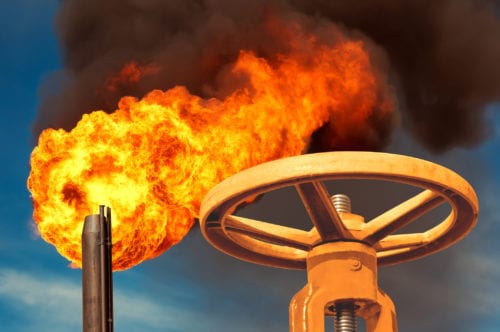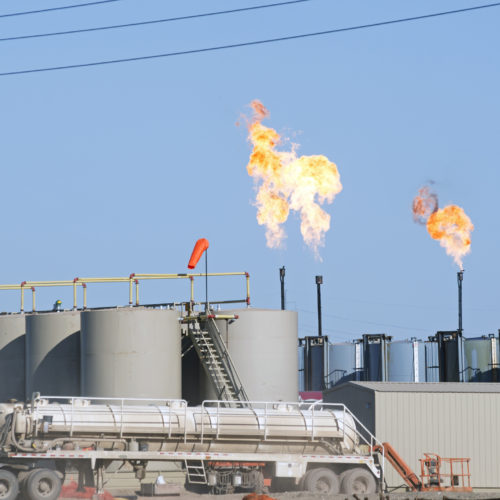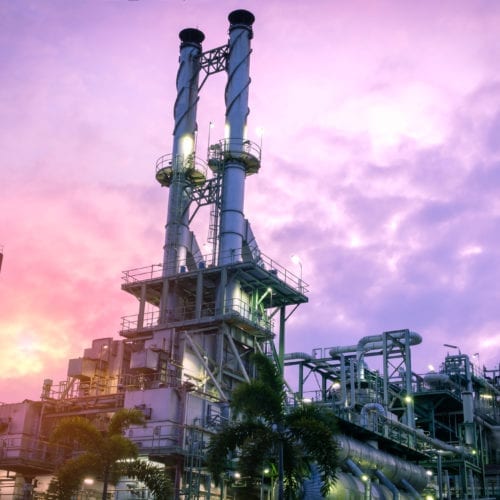Gas valve on the background of flaming torch flame

Disaster Rollbacks: The Methane Danger to Our Health and Climate
Over the last few months, in addition to facing a dire health crisis, we have all been witness to unexpected disruptions in our systems and society. Along with the disruptions of basic daily life such as work, childcare, and shopping for basic necessities, many industries have been hard-hit by the ripple effects of the virus, including the travel, shipping, and oil and gas industries.
While the near-term effects on these industries are serious and need to be addressed, some organizations are using the COVID-19 crisis as an opportunity to abandon environmental safeguards they have been trying to eliminate for some time now, including methane regulations for the oil and gas industry. This would lead to a huge increase in methane emissions—a super potent greenhouse gas—something that would be catastrophic both for our climate and our health.
Evaporating Environmental Regulations
Last week, while public attention was focused overwhelmingly on mounting coronavirus cases, the Environmental Protection Agency (EPA) and National Highway Traffic Safety Administration finalized a new fuel economy rule that will essentially allow nearly 1 billion metric tons of CO2 to be emitted into our environment. Not only does this new rule put more pollution into our air, it could also cost consumers more in the long run.
In California, ports and dockworkers are asking to delay new rules, under consideration by the California Air Resources Board, that will reduce air pollution from cargo ships. While these ports and dockworkers are arguing that they need to focus their efforts on addressing the COVID-19 crisis, the truth of the matter is that the industry had expressed its opposition to the new rule well before COVID-19.
We also see this same trend in the oil and gas industry. In March, the EPA announced that it was freezing enforcement on environmental regulations due to the coronavirus pandemic and would not “seek penalties for violations of routine compliance monitoring, integrity testing, sampling, laboratory analysis, training, and reporting or certification obligations in situations where the EPA agrees that COVID-19 was the cause of the noncompliance.”
This easing of restrictions was issued five days after the EPA received a detailed letter from the American Petroleum Institute asking the government to temporarily lift some compliance obligations during the coronavirus pandemic, including regulations around methane emissions from oil and gas operations. However, there is nothing new about the weakening of regulations on these emissions, which pack more than 80 times the global warming power of CO2.
Last August, the EPA proposed a rule that would eliminate federal requirements that oil and gas companies install technology to detect and repair methane leaks. And last week, the EPA’s Science Advisory Board said it did not have adequate time to review the provisions of this proposed rule due to the agency’s ambitious timeline for finalizing it.
The Declining Role of Gas
As discussed in our recent report, The Role of Gas in the Energy Transition, the pre-COVID patchwork of voluntary and regulatory actions was already failing to drive methane emissions reductions at the scale and speed necessary for climate alignment, the process of aligning operational and investment decisions with a downward path toward long-term decarbonization targets. A weakening of these regulations will only make things worse.
Natural gas will play an important but declining role in the energy transition. There is a growing consensus that most, if not all, of the gas currently used in buildings and power plants can and must be replaced with readily available clean energy and clean electricity options. The timeline for phasing out gas in the industrial sector remains uncertain, as global efforts work to scale a range of potential alternatives to both coal and gas, the key thermal energy inputs in heavy manufacturing.
As we phase out gas, we have a much higher likelihood of meeting our climate goals if we are also minimizing methane emissions, both intentional and accidental, from the gas value chain. Methane emissions from oil and gas production, processing, transmission, and distribution total over 6.7 billion tons CO2-equivalent emissions each year, equal to 16 percent of all humanmade CO2 emissions.
Industry and States are Stepping Up
On a positive note, we continue to see more awareness of the issue, and more action on behalf of the industry and individual states. Major energy companies, including ExxonMobil, Shell, and BP, spoke out against the EPA’s proposed methane role when it was announced last year. More recently, the Norwegian energy company, Equinor, quit an industry lobbying group, the Independent Petroleum Association of America, because of a disagreement on climate policy, and cited the EPA’s rollback of methane regulations as a reason for leaving the group.
Similarly, last year, Shell and Total said they would not renew their membership in the American Fuel and Petrochemical Manufacturers refining lobby group because of disagreements over climate policy. BP followed suit this February.
In the US, 25 attorneys general, including those from states with major oil and gas operations like Pennsylvania, Colorado, and California, sent a letter to the EPA stating that the proposed revisions to the EPA’s methane regulations will significantly degrade air quality and impact public health. Over the last several years, these states have been working on their own to enact regulations that protect their residents from pollution that is harmful to their health and our environment.
For example, in February of 2014, Colorado became the first state to adopt rules to limit methane emissions. In 2017, the Pennsylvania Department of Environmental Protection announced a new permitting process that required controlling methane and other pollutant emissions from new gas wells, transmission stations, and pipelines.
The Need for Transparent Data
While these actions are all a step in the right direction, there is still a lack of transparency into whether a company’s claimed methane emissions reductions are actually occurring in practice. Two things are essential to curbing methane emissions from the oil and gas industry:
- Global adoption of a methane emissions standard for gas that clearly defines the rules industry must comply with during this transition.
- A trusted source of transparent and accessible data, coupled with creative analytical approaches, that can translate data into methane abatement action by operators, investors, consumers, and regulators.
RMI’s work is focused squarely in these two areas. Together, a global methane emissions standard for gas and novel data-driven approaches to emissions visibility and prediction can enable the reductions we need in the next decade to meet our climate goals. This work depends on solid data, including that collected by academics and NGO partners like the Environmental Defense Fund, which this week released new data from its PermianMAP effort that showed oil and gas producers in the Permian Basin are releasing methane at three times the rate reported in the Environmental Protection Agency’s nationwide statistics.
Managing methane that escapes the natural gas supply chain is critical to combating climate change, but it’s also critical to our health. Air pollution, which had been on the rise until the COVID crisis, puts people at higher risk for severe illness from coronavirus, and those living in polluted cities are at greater risk. One of the rare benefits we’ve seen from our current state is cleaner air, but these temporary benefits won’t last, especially if we keep lessening restrictions. As we’ve stated before, the COVID-19 crisis is a harbinger of things to come, and if we’ve learned one thing, it’s that we can’t put off preparing for the future.
To learn more about our methane abatement work, contact us at methane-contact@rmi.org or visit our website.

